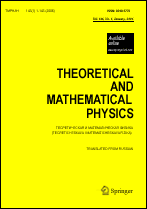|
This article is cited in 74 scientific papers (total in 74 papers)
Renyi entropy as a statistical entropy for complex systems
A. G. Bashkirov
Institute of Dynamics of Geospheres, Russian Academy of Sciences
Abstract:
To describe a complex system, we propose using the Renyi entropy depending on
the parameter $q$ $(0<q\le1)$ and passing into the Gibbs–Shannon entropy at
$q=1$. The maximum principle for the Renyi entropy yields a Renyi
distribution that passes into the Gibbs canonical distribution at $q=1$.
The thermodynamic entropy of the complex system is defined as the Renyi entropy
for the Renyi distribution. In contrast to the usual entropy based on
the Gibbs–Shannon entropy, the Renyi entropy increases as the distribution
deviates from the Gibbs distribution {(}the deviation is estimated by
the parameter $\eta=1$ – $q)$ and reaches its maximum at the maximum possible value
$\eta_{\max}$. As this occurs, the Renyi distribution becomes a power-law
distribution. The parameter $\eta$ can be regarded as an order parameter.
At $\eta=0$, the derivative of the thermodynamic entropy with respect to
$\eta$ exhibits a jump, which indicates a kind of phase transition into
a more ordered state. The evolution of the system toward further order in this
phase state is accompanied by an entropy gain. This means that in accordance
with the second law of thermodynamics, a natural evolution in the direction
of self-organization is preferable.
Keywords:
Renyi entropy, complex system, self-organization, phase transition, power-law Zipf–Pareto distribution, second law of thermodynamics, direction of evolution.
Received: 12.01.2006
Revised: 16.06.2006
Citation:
A. G. Bashkirov, “Renyi entropy as a statistical entropy for complex systems”, TMF, 149:2 (2006), 299–317; Theoret. and Math. Phys., 149:2 (2006), 1559–1573
Linking options:
https://www.mathnet.ru/eng/tmf4235https://doi.org/10.4213/tmf4235 https://www.mathnet.ru/eng/tmf/v149/i2/p299
|


| Statistics & downloads: |
| Abstract page: | 3094 | | Full-text PDF : | 1495 | | References: | 156 | | First page: | 6 |
|




 Contact us:
Contact us: Terms of Use
Terms of Use
 Registration to the website
Registration to the website Logotypes
Logotypes








 Citation in format
Citation in format 
